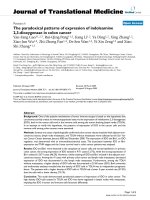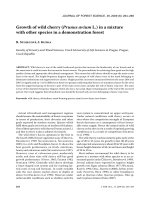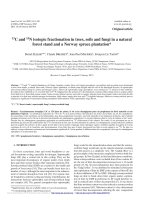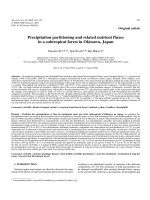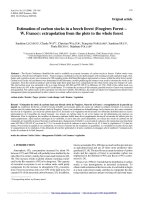2.3 Life in a rain forest (life science)
Bạn đang xem bản rút gọn của tài liệu. Xem và tải ngay bản đầy đủ của tài liệu tại đây (3.37 MB, 14 trang )
Genre
Nonfiction
Comprehension Skill
Cause and Effect
Text Features
•
•
•
•
Captions
Map
Labels
Glossary
Science Content
Plants and
Animals
Scott Foresman Science 2.3
ISBN 0-328-13777-4
ì<(sk$m)=bdh ha< +^-Ä-U-Ä-U
Vocabulary
Extended Vocabulary
consumer
food chain
food web
predator
prey
producer
algae
emergent
equator
layers
nectar
pollen
Picture Credits
Every effort has been made to secure permission and provide appropriate credit for photographic material.
The publisher deeply regrets any omission and pledges to correct errors called to its attention in subsequent editions.
Photo locators denoted as follows: Top (T), Center (C), Bottom (B), Left (L), Right (R), Background (Bkgd).
9 (B) Stephen Dalton/NHPA Limited; 12 (C) Neil Nightingale/Nature Picture Library,
(R) Terry Whittaker/Frank Lane Picture Agency/Corbis; 13 (B) ©Jerry Young/DK Images.
Scott Foresman/Dorling Kindersley would also like to thank: 16 (B) Jerry Young/DK Images;
18 (R) Jerry Young/DK Images.
Unless otherwise acknowledged, all photographs are the copyright © of Dorling Kindersley, a division of Pearson.
ISBN: 0-328-13777-4
Copyright © Pearson Education, Inc. All Rights Reserved. Printed in the United States of America.
This publication is protected by Copyright, and permission should be obtained from the publisher prior to any
prohibited reproduction, storage in a retrieval system, or transmission in any form by any means, electronic,
mechanical, photocopying, recording, or likewise. For information regarding permission(s), write to
Permissions Department, Scott Foresman, 1900 East Lake Avenue, Glenview, Illinois 60025.
3 4 5 6 7 8 9 10 V010 13 12 11 10 09 08 07 06 05
What did you learn?
1. What are the layers of a rain forest?
2. How do archer fish get food?
3.
Monkeys live in
the canopy of the rain forest. Write
by their
Shirley
Horton
to explain how
bodies
help
them live in the trees. Use words
from this book as you write.
4.
Cause and Effect What might
happen if a bird or a lizard gets too
close to a boa?
What You Already Know
Plants and animals need each other to
live. Sometimes plants and animals help
each other find food and shelter. Sometimes
they protect each other. Sometimes they eat
each other!
Plants make food with energy from the
Sun. Many animals eat plants. Other animals
eat these animals. This is called a food chain.
Living things that make their own food,
like plants, are called producers. Animals that
eat other living things are called consumers.
Some animals hunt other animals for
food. They are called predators.
Some animals get hunted. They
are called prey. Food chains
have predators and prey.
A food web is when many food chains
happen in one place. Food webs are
found in many environments. Sometimes
food webs change.
In this book you will read about how
plants and animals live together in a rain
forest. You will learn about the parts of a
rain forest. You will meet many different
plants and animals that live in each part.
This chameleon is using its long
tongue to catch an insect.
2
3
What is a rain forest?
Look at the map below. The red line is
the equator. It is an imaginary line that
goes all around the middle of the world.
Right over and under the line is where rain
forests grow.
Plants in these forests grow tall, thick,
and green. This is because the weather
there is warm and wet.
There are different layers in a rain forest,
like the layers of a cake.
Rain Forest Layers
Emergent layer—the tops
of the tallest trees reach
sunlight and air here.
Canopy—the tops
of some trees and
plants make a lot
of shade here.
Understory—the trunks
of tall trees and the tops
of some short plants
reach here.
equator
South
America
(Amazon
rain forest)
On this map, the dark green places are rain forests.
4
Forest floor—this is the
ground level where
trees and plants begin
to grow.
Rivers—rainwater runs
off forest leaves and
branches here.
5
The River
Many kinds of fish
live and lay their eggs
in the rivers of rain
forests. Most fish eat
insects that fall into
the water. Archer
fish do not wait for
their dinner to come
to them. They knock
insects off low-hanging
plants. Then, gulp!
archer fish
Piranhas are fast
fish with lots of very
sharp teeth. They like
nibbling the fins of
other fish for food.
Snip, snip!
Caimans, like
alligators, are
water reptiles. When
hunting, they can
hide under the water
with their eyes just
above it. Then, snap!
piranha
caiman crocodile
6
7
The Riverbank
Tapirs are mammals. They look
for plants to eat at night. They
have to be careful when they look
for food. Predators, such as large
snakes and water reptiles,
are watching for
tapirs to eat!
Anacondas are big
snakes. Sometimes
they hunt for food in
the river. Other times
they hunt in the trees.
Anacondas coil around their
prey. Then they swallow their prey
in one big gulp.
Basilisk lizards are small, light,
and fast. These reptiles can run
across the water on their back
legs as they chase their food.
anaconda
basilisk lizard
tapir
8
9
The Forest
Gorillas are big apes that live in lowland
or mountain rain forests. They spend their
days playing, sleeping, and eating on the
forest floor. At night,
young gorillas sleep
in nests in the trees.
Other gorillas build
their nests on
the ground.
gorilla
10
10
Insects and spiders also
live on the forest floor.
Wasps and bees drink
nectar from forest flowers.
They carry pollen from
flower to flower. This
helps fruit to grow.
Tarantulas are big
spiders. They move fast
through the leaves on the
forest floor. They have
hair all over!
paper
wasps
tarantula
11
Some flowers grow on the
dark forest floor. Rafflesia
(rah-FLEE-zhah) flowers have
no stems or leaves. They live
on the roots or stems of other
plants. Rafflesias are the
largest flowers ever found.
rafflesia
The Understory
Some of the animals that live
among the leaves, branches, and
vines of the understory never go
down to the forest floor. Bats sleep
in the day, hanging from branches.
At night they zip through the
trees hunting for food. Some bats
eat only insects. Others, like this
vampire bat, eat animal blood.
vampire bat
12
13
Many plants
growing from
branches in the
understory are
shaped like cups.
These plants can
hold rainwater.
Tree frogs lay their
eggs in these plant
cups. The frogs also
hide in these plants to wait
for insects to fly by. They
eat the insects they catch.
golden tree boa
red-eyed
tree frog
Chameleons are lizards. They
change their colors to look like
the forest around them. This
camouflage helps them stay safe.
Boas are snakes that curl up in
tree branches. They trap birds and
lizards that get too close. Then they
strike, squeeze, and swallow.
chameleon
14
15
The Canopy
Lots of different kinds
of orchids grow in
the canopy. People
around the world
love these beautiful
flowers. People take
these flowers to many
other places to grow.
orchid
Many swinging
and flying animals
live in the canopy.
Tiny green plants
called algae
grow in the hair
of big sloths.
These plants grow
because a sloth’s fur
is wet from the rain.
Unlike other canopy
birds, toucans have very long
beaks. Their beaks are long,
but they are very light.
toucan
sloth
16
17
Monkeys live in the
canopy too. These
animals swing and
leap through their
treetop homes. They
are made to move
well in the trees. They
have long arms and
tails. They have hands
and feet that can grip
the branches.
spider
monkey
18
squirrel monkey
Monkeys can
stay safe in their
treetop homes. As
long as they stay
up in the trees, they
cannot be eaten!
Gibbons are small apes.
They are like monkeys
in many ways but they
have no tails.
siamang gibbon
19
The Emergent Layer
Rain forest butterflies fly
in the emergent layer. The
blue morpho butterfly
is easy to spot. It is
bright blue. Predators
are fooled by the way
this butterfly looks.
Predators think it is a
flower. They stay away
and the butterfly stays safe.
marmoset
blue morpho
butterfly
Marmosets are
little monkeys that
eat insects and fruit.
They can move through the
treetops. They cannot hold on
with their tails and hands as
well as other monkeys.
Colobus monkeys almost never
go down to the floor of the forest.
They find most of the food they
eat in the trees. These monkeys
have very long tails to help
them move in the trees.
colobus
monkey
20
21
These birds are parrots.
They fly through the
emergent layer to
find food. They
make loud
noises as they
fly. Parrots and
their eggs are the
prey of many forest
animals. They are also
hunted by people
who sell them as pets.
rainbow
lorikeet
parakeet
If you ever visit a rain
forest, watch for these
beautiful birds and for the
other animals you have
read about. You will not see
them all in the same rain
forest. At first, you may not
even see any of them. But
keep watching. Some of
them will be watching you!
macaw
22
23
Extended Vocabulary
Vocabulary
Glossary
algae
consumer
emergent
food chain tiny plants
algae
that grow in water
equator
food web
predator
emergent
coming layers
up into the sunlight
nectar
prey
pollencircle around
producer an imaginary
equator
the middle of the Earth
layers
parts that go on top of one
another
nectar
a sweet liquid found in many
flowers
pollen
a fine powder that comes
from flowers
Picture Credits
Every effort has been made to secure permission and provide appropriate credit for photographic material.
The publisher deeply regrets any omission and pledges to correct errors called to its attention in subsequent editions.
Photo locators denoted as follows: Top (T), Center (C), Bottom (B), Left (L), Right (R), Background (Bkgd).
9 (B) Stephen Dalton/NHPA Limited; 12 (C) Neil Nightingale/Nature Picture Library,
(R) Terry Whittaker/Frank Lane Picture Agency/Corbis; 13 (B) ©Jerry Young/DK Images.
Scott Foresman/Dorling Kindersley would also like to thank: 16 (B) Jerry Young/DK Images;
18 (R) Jerry Young/DK Images.
Unless otherwise acknowledged, all photographs are the copyright © of Dorling Kindersley, a division of Pearson.
ISBN: 0-328-13777-4
Copyright © Pearson Education, Inc. All Rights Reserved. Printed in the United States of America.
This publication is protected by Copyright, and permission should be obtained from the publisher prior to any
prohibited reproduction, storage in a retrieval system, or transmission in any form by any means, electronic,
mechanical, photocopying, recording, or likewise. For information regarding permission(s), write to
Permissions Department, Scott Foresman, 1900 East Lake Avenue, Glenview, Illinois 60025.
24
3 4 5 6 7 8 9 10 V010 13 12 11 10 09 08 07 06 05
What did you learn?
1. What are the layers of a rain forest?
2. How do archer fish get food?
3.
Monkeys live in
the canopy of the rain forest. Write
to explain how their bodies help
them live in the trees. Use words
from this book as you write.
4.
Cause and Effect What might
happen if a bird or a lizard gets too
close to a boa?




